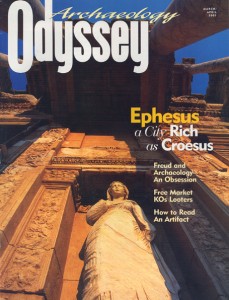Archaeology Odyssey, March/April 2001
Features
Freud
“Schliemann of the mind”
In an 1896 lecture on the causes of hysteria, Sigmund Freud provided his audience with an elaborate archaeological analogy: “Imagine that an explorer arrives in a little-known region where his interest is aroused by an expanse of ruins, with remains of walls, fragments of...Read more ›
Ephesus Uncovered
From latrines to libraries
Unlike other great Hellenistic/Roman cities—Alexandria, Antioch, Rome, Constantinople—Ephesus was abandoned in antiquity. These other cities continue to thrive today, which, unfortunately for archaeologists, means that they cannot be excavated, at least not completely. The principal remains we have from ancient Alexandria, for example, are catacombs and debris...Read more ›
How to Reduce Archaeological Looting
Open the market and enlist the collectors!
Readers of Archaeology Odyssey are no doubt aware of the magazine’s dedication to finding a realistic and effective solution to the problem of rampant archaeological looting. As economists, we first became interested in archaeological regulations and markets in artifacts after reading about the public uproar concerning the...Read more ›
Ideology from Artifacts
How ancient objects reveal the social reality of their time
We tend to think of ancient objects as either useful or beautiful—or both. A bit of text scratched on a clay tablet is used to communicate or record information; a finely filigreed golden earring is thought to be lovely; an elegant stairway, perhaps leading into the adyton...Read more ›

